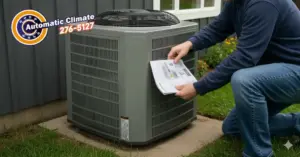Which is better? Traditional HVAC vs. Mini-Split Systems
Overview of HVAC Systems
Traditional HVAC systems have been the industry standard for decades. These systems rely on a central unit that circulates conditioned air through a network of ducts, providing uniform temperature control throughout the home. However, as many have discovered, ductwork can be prone to leaks and energy loss, reducing the overall efficiency of the system. In the ongoing debate of HVAC vs. mini-split systems, traditional systems are praised for their familiarity and proven track record, yet criticized for their complexity and maintenance challenges.
In contrast, ductless mini-split systems have emerged as a modern alternative that eliminates the need for ducts. Instead, an outdoor compressor connects to one or more indoor air handlers via refrigerant lines. This design not only reduces energy loss but also allows for zone-specific control, meaning you can adjust the temperature in each room independently. This feature is especially valuable in homes with varied occupancy patterns or rooms that receive different amounts of sunlight.
For example, if you are highly focused on energy efficiency, you might explore resources like Consumer Reports – Best Heat Pump Buying Guide to learn more about how each system compares in energy usage. Additionally, installation costs are a critical factor: traditional HVAC systems often require extensive ductwork installation, which can increase both cost and complexity, whereas mini-split systems are generally less invasive and faster to install.
The keywords HVAC vs. mini-split appear throughout this article to emphasize our focus on comparing these two approaches. Secondary keywords such as energy efficiency, installation cost, maintenance tips, and comfort control are integrated into our discussion and linked to authoritative sources to support our analysis.
Detailed Comparison: HVAC vs. Mini-Split
When evaluating HVAC vs. mini-split systems, the pros and cons become evident on several fronts. Traditional HVAC systems provide centralized control and uniform air distribution, which can be ideal for larger homes. Yet the downsides include the energy losses incurred from long ducts and the potential for uneven temperature zones if the duct system is not perfectly balanced.
On the flip side, mini-split systems deliver conditioned air directly into individual rooms. This direct delivery system minimizes energy waste and offers unparalleled control over each zone’s temperature. Homeowners can adjust each indoor unit to meet specific needs, resulting in enhanced comfort and energy savings over time. Furthermore, because mini-split systems eliminate ductwork, the common issues of dust accumulation and air leakage are significantly reduced.
For instance, many experts cite that the energy efficiency of ductless systems can lead to a reduction in energy bills by 30-35% compared to traditional HVAC. This efficiency is especially appealing as energy costs continue to rise and environmental concerns become more pressing. The HVAC vs. mini-split discussion is thus not only technical—it also involves long-term economic considerations and environmental impact.
Installation cost is another key element. Traditional systems often have a higher upfront cost due to the labor and materials required for ductwork. In contrast, mini-split systems typically have lower installation costs because they require only small holes for refrigerant lines. This aspect can be a decisive factor for many homeowners renovating older homes where adding ductwork would be impractical.
Maintenance is also an important aspect of the HVAC vs. mini-split debate. Traditional HVAC systems require routine duct cleaning and frequent filter replacements. The complexity of ductwork can result in higher maintenance expenses over the years. Mini-split systems, however, are designed for easier upkeep: their filters are accessible and cleaning is straightforward, leading to lower long-term maintenance costs.
Comfort control further distinguishes these two systems. A traditional HVAC system is typically controlled by a single thermostat, meaning adjustments affect the entire house. In contrast, mini-split systems allow for individual control of each indoor unit. This means that if one room requires extra cooling or heating, it can be addressed without impacting the rest of the home.
Uniform cooling for large areas
Customized, zone-specific control
In-Depth Analysis: Long-Term Considerations
The long-term impact of HVAC vs. mini-split involves more than just upfront and maintenance costs. Traditional HVAC systems, while reliable, often come with hidden expenses such as duct repairs, system inefficiencies due to duct losses, and higher energy consumption over time. Conversely, mini-split systems offer lower long-term energy costs because their design eliminates ductwork losses. Homeowners have reported that switching to a mini-split system can yield energy savings of up to 35%, making them an attractive long-term investment.
In the HVAC vs. mini-split discussion, environmental benefits also play a crucial role. Mini-split systems are inherently more energy efficient, leading to reduced carbon emissions. As governments and utility companies increasingly offer incentives for green installations, the environmental advantages of mini-splits become even more compelling. This system not only lowers your energy bill but also contributes to a smaller carbon footprint.
Moreover, mini-split systems allow for individualized temperature control. With a traditional HVAC system, a single thermostat controls the entire home, which can result in wasted energy if only part of the house is occupied. Mini-splits, however, empower homeowners to heat or cool only the rooms that are in use. This precise control not only improves comfort but also maximizes energy efficiency.
The economic benefits are equally significant. Lower installation costs, fewer maintenance requirements, and substantial energy savings can lead to a faster return on investment when choosing a mini-split system. Many industry experts now recommend mini-splits for their overall cost-effectiveness, especially in homes where precise zone control is desired.
As Henry Ford famously said, “If everyone is moving forward together, then success takes care of itself.” This quote captures the innovative spirit driving mini-split technology and its increasing adoption in modern homes. With streamlined installation, improved energy efficiency, and simpler maintenance, mini-split systems offer a promising path forward in the HVAC vs. mini-split debate.
When evaluating these systems, it is essential to consider your home’s layout, energy goals, and budget. For instance, in a multi-story home with varying sun exposures, mini-splits provide the flexibility to set different temperatures for each floor or even each room. Traditional systems, while effective, may not offer this level of customization without significant additional expense.
Additionally, the ease of integrating mini-split systems with modern smart home technology cannot be overlooked. Many mini-split systems now come with built-in smart controls, allowing homeowners to adjust settings remotely and schedule operation times. This integration enhances both convenience and energy savings.
Maintenance and Upkeep Insights
Maintaining a home’s heating and cooling system is critical for ensuring long-term efficiency and comfort. In the HVAC vs. mini-split debate, maintenance demands are a major differentiator. Traditional HVAC systems require regular servicing of ductwork, frequent filter changes, and periodic professional inspections to address potential leaks and inefficiencies. These tasks can be both time-consuming and costly.
Mini-split systems, on the other hand, are designed with simplicity in mind. Their ductless design means there is no ductwork to clean, and filters are typically accessible from the front of the unit. Homeowners can often clean or replace filters themselves every 2-3 months, significantly reducing maintenance time and expense. This ease of maintenance is a major selling point in the HVAC vs. mini-split discussion.
Routine maintenance tasks include checking refrigerant levels, cleaning or replacing filters, and ensuring that the outdoor compressor unit is free of debris. With traditional systems, neglected ducts can lead to poor air quality and reduced performance. Mini-split systems, with their straightforward design, reduce these risks considerably.
For detailed maintenance tips, you might explore resources like Automatic Climate HVAC – Air Duct Cleaning, which offers practical advice on keeping your system in top shape.
Regular filter changes
Higher repair and maintenance costs
Simpler servicing
Lower overall maintenance expense
Further Analysis: Environmental & Economic Impact
In today’s eco-conscious market, the environmental impact of your heating and cooling system is a key factor. Mini-split systems, due to their high energy efficiency, contribute to reduced energy consumption and lower greenhouse gas emissions. This is particularly important as utility costs rise and governments offer incentives for green installations.
Additionally, the economic benefits of mini-split systems extend beyond lower monthly energy bills. The reduced need for invasive ductwork installation and the simplified maintenance routines contribute to significant long-term savings. Many homeowners have reported that the return on investment for ductless systems is achieved much faster than with traditional HVAC systems.
Moreover, mini-split systems can be easily integrated with smart home technology, allowing homeowners to control their system remotely and schedule operation times based on occupancy. This smart integration not only boosts energy savings but also enhances overall home comfort.
As Thomas Edison once stated, “There’s a way to do it better – find it.” This innovative spirit underpins the shift toward mini-split systems, which continuously evolve to meet modern standards for energy efficiency and sustainability.
In summary, when evaluating HVAC vs. mini-split systems, the environmental and economic impacts strongly favor mini-split systems. Reduced energy consumption, lower installation and maintenance costs, and the potential for smart technology integration make them an increasingly attractive option for many homeowners.
Take Action and Learn from Real Success
Deciding between traditional HVAC and mini-split systems (HVAC vs. mini-split) requires careful evaluation of your home’s unique needs. If you prioritize energy savings, lower maintenance costs, and individualized comfort control, mini-split systems are a highly attractive choice. Conversely, if your home benefits from centralized air distribution and you value a long-proven system design, a traditional HVAC might still be ideal.
It is essential to weigh these factors along with considerations such as installation disruption, system noise, and the potential for smart technology integration when making your decision.
FAQs
Get Expert Help
EXCELLENTTrustindex verifies that the original source of the review is Google. Aaron J. Visited our home later this evening to follow up with today’s install and the system checked out as it should. The only issue we had was connecting and setting up the wireless thermostat due to the app issues. He was very professional and patient. John and Joe replaced our 2nd floor gas heating system in a professional manner. Everything went smooth according to them and they finished the job in less time than expected. Aaron was professional and extremely thorough during his visit to our home. He took the time to explain the workings of our HVAC system and answered every question. To add to the above, I called the office and spoke with both Austin and Jason who were also very helpful while explaining the warranty and transfer of same. We are extremely pleased with Automatic Climate and will highly recommend to anyone who may ask for recommendations.
Owner's reply
Thank you for sharing your positive experience! We're thrilled Aaron, Austin, and Jason could assist you so thoroughly. Your recommendation means a lot, and we're glad we could help with your HVAC system and warranty details.Posted onTrustindex verifies that the original source of the review is Google. I had a very positive experience with them. They had better financing options, better prices, and were more responsive than other companies I got quotes from. Michael Chris and the whole team were fantastic. Highly recommendPosted onTrustindex verifies that the original source of the review is Google. Technician was on time, personable and professional. He throughly explained everything that he was going to do and identified any concerns. Very pleased with the overall experience and would recommend to other homeownersPosted onTrustindex verifies that the original source of the review is Google. I had the coils cleaned in my tankless water heater. Aaron Jernigan was so seemingly competent, so well-mannered, so good explaining what was going on, I am considering switching to Automatic Climate, I will definitely have all the vents in my house blown out in the near future.Posted onTrustindex verifies that the original source of the review is Google. Fast, friendly, knowledgeable and professional. Their associate, Casey J, helped fix our heat when we were enduring 20-30 degree nights. Thank you so much!!Posted onTrustindex verifies that the original source of the review is Google. Charlie was very dedicated. Provided excellent service. Very impressed with his dedication. Did check on HVAC and cleaned drier vent in Condo we purchased last summer.Posted onTrustindex verifies that the original source of the review is Google. I've been a customer of Automatic Climate for several years. I value the services of this firm. My commitment to renewing my maintenance contract year after year is directly related to the technical expertise of one of the company’s many representatives, Antonio Diaz. Antonio has kept all three of my units running smoothly for years, and when necessary forewarns me early of any pending issues. He offers solutions right away without long waits for follow up. I've never had to call the company back to correct any of his work. Antonio attributes his success and extraordinary customer service to the culture of Automatic Climate. I would recommend Antonio and Automatic Climate to any of my friends and neighbors. They're a company you can trust.
Owner's reply
Thank you so much for your kind words! We're thrilled to hear you had a positive experience with our service.Posted onTrustindex verifies that the original source of the review is Google. John & Nick were here today to clean our air ducts. They were very thorough and made sure that they left our home as clean as when they arrived. They explained the process clearly and worked efficiently. Great job!Verified by TrustindexTrustindex verified badge is the Universal Symbol of Trust. Only the greatest companies can get the verified badge who has a review score above 4.5, based on customer reviews over the past 12 months. Read more
SKip The Line! Schedule Your HVAC Service by Booking Online Now.
Exclusive Promotions and Coupons

$39 A/C
Tune-Up!
Take advantage of this limited time offer. Keep your home cool this summer with Automatic Climate!*
*Expires 12/30/25. Offer can’t be combined with other offers or promotions. Offer valid for existing and new clients.

$50 OFF Air
Duct Cleaning
Save $50 on your next air duct cleaning service for a limited time!*
*Expires 12/30/25. Offer can’t be combined with other offers or promotions. Offer valid for existing and new clients.

$49 Water
Heater Flush
Take advantage of this $49 water heater flush and make sure your water is heating properly!*
*Expires 12/30/25. Offer can’t be combined with other offers or promotions. Offer valid for existing and new clients.








